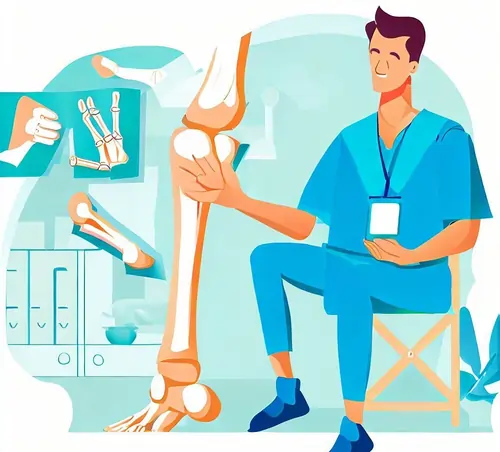Fracture Care in Orthopedic Nursing

Orthopaedic nursing is a specialized field of nursing that focuses on the care of patients with musculoskeletal conditions, including fractures. Fractures are common injuries that can occur due to various reasons, such as accidents, falls, or sports injuries. As a nursing student, understanding fracture care in orthopaedic nursing is crucial, as it equips you with the knowledge and skills needed to provide effective care to patients with fractures. In this blog, we will delve into the essentials of fracture care in orthopaedic nursing, with a particular focus on how students can complete their nursing assignment related to this topic.
Understanding Fractures
Before we delve into the nursing aspect of fracture care, it's essential to have a solid understanding of what fractures are and the different types. Fractures occur when there is a break in the continuity of a bone. There are several types of fractures, including:

- Closed Fracture:
- A closed fracture, also known as a simple fracture, occurs when a bone is broken, but the skin covering it remains intact.
- These fractures are often caused by traumatic events, such as falls, accidents, or sports injuries.
- The absence of an open wound reduces the risk of infection, which is one of the advantages of closed fractures.
- However, closed fractures can still cause significant pain, swelling, and internal bleeding at the fracture site.
- Open Fracture:
- An open fracture, also called a compound fracture, is characterized by a bone breaking through the skin's surface.
- Open fractures are particularly concerning because they expose the internal bone to the external environment, significantly increasing the risk of infection.
- Immediate medical attention is crucial for open fractures to minimize the risk of contamination and ensure proper wound care.
- The severity of open fractures is often classified into different grades, ranging from I (minimal skin damage) to III (extensive soft tissue damage).
- Comminuted Fracture:
- In a comminuted fracture, the bone is shattered into multiple pieces or fragments.
- These fractures often result from high-impact injuries, such as car accidents or heavy falls.
- Treating comminuted fractures can be challenging, as the fractured bone may require surgical intervention to realign and stabilize it.
- Due to the complexity of comminuted fractures, they may take longer to heal and can be associated with complications like delayed union or nonunion.
- Greenstick Fracture:
- Greenstick fractures are unique and are most commonly seen in children due to the flexibility and resilience of their bones.
- In a greenstick fracture, the bone is partially broken, similar to how a green twig bends but does not break completely.
- The fracture typically occurs on the convex side of the bone, while the concave side remains intact.
- These fractures may not be as visibly severe as other types but still require proper assessment and care to ensure complete healing.
- Stress Fracture:
- Stress fractures are a distinct type of fracture caused by repetitive stress or overuse of a bone.
- They are often seen in athletes and individuals engaged in activities that involve repetitive impact, such as running or jumping.
- Stress fractures typically develop gradually and may initially present as mild pain that worsens with activity.
- Early diagnosis and intervention are essential to prevent the fracture from progressing to a more severe state.
Assessment and Diagnosis
When caring for a patient with a fracture, the nursing process begins with a thorough assessment. As a nursing student, it's crucial to understand the key components of this assessment:
- Patient History:
- Gathering a comprehensive patient history is the first step in assessing a fracture. It provides valuable context for the injury.
- Information about the circumstances of the fracture, such as the mechanism of injury (e.g., fall, motor vehicle accident) and the location of the event, helps in understanding the potential forces involved.
- Knowledge of pre-existing medical conditions, such as osteoporosis or diabetes, and medications the patient is taking is essential as they can impact fracture healing and treatment decisions.
- Physical Examination:
- A thorough physical examination of the affected area is crucial to assess the extent of the injury.
- Signs of swelling, deformity, and bruising can indicate the severity and location of the fracture.
- Neurovascular assessment involves evaluating sensory (feeling) and motor (movement) function in the injured limb to detect any nerve or vascular damage.
- These findings guide immediate interventions, such as immobilization and pain management, and help monitor the patient's progress throughout treatment.
- Imaging:
- Diagnostic imaging, including X-rays, CT scans (computed tomography), and MRIs (magnetic resonance imaging), plays a pivotal role in confirming the presence of a fracture and determining its exact location and extent.
- X-rays are often the initial choice for diagnosing fractures due to their speed and effectiveness in providing clear images of bone structures.
- CT scans and MRIs may be used for more complex fractures or when soft tissue and joint involvement need to be assessed.
- These imaging studies guide treatment decisions, such as whether surgery is necessary and how to properly position and immobilize the fractured bone.
Nursing Interventions
Nursing care for patients with fractures involves a range of interventions aimed at promoting healing, relieving pain, and preventing complications:
- Immobilization: Depending on the type and location of the fracture, immobilization techniques may include casts, splints, or external fixation devices.
- Pain Management: Administering pain medications as prescribed and assessing the effectiveness of pain relief.
- Neurovascular Assessment: Regularly assess circulation, sensation, and movement in the affected limb to detect any signs of vascular compromise.
- Wound Care: For open fractures, meticulous wound care is essential to prevent infection.
- Nutrition: Ensure that the patient receives a balanced diet rich in nutrients that support bone healing.
- Physical Therapy: Coordinate with physical therapists to develop a rehabilitation plan to help the patient regain mobility and strength.
Nursing Assignments on Fracture Care
Nursing assignments on fracture care in orthopaedic nursing can be both informative and practical. Here's how students can approach such assignments effectively:
- Research: Start by conducting thorough research on the topic, including recent advancements in fracture care and evidence-based practices.
- Case Studies: Analyze real-life case studies of patients with fractures, discussing their assessment, nursing interventions, and outcomes.
- Patient Education: Create patient education materials that explain fracture care, rehabilitation exercises, and potential complications.
- Interdisciplinary Approach: Highlight the importance of collaboration with other healthcare professionals, such as surgeons, physical therapists, and radiologists, in providing holistic care.
- Ethical Considerations: Discuss ethical dilemmas that may arise in fracture care, such as informed consent for surgery or end-of-life decisions in severe cases.
Conclusion
In the world of orthopaedic nursing, fracture care is a fundamental skill. As a nursing student, mastering this skill is not only essential for your academic success but also for your future career as a nurse. Approach assignments on fracture care with dedication and a commitment to staying updated on the latest practices. By doing so, you'll be well-prepared to provide high-quality care to patients with fractures and contribute to the field of orthopaedic nursing.Remember, for more information and assistance with nursing assignments, you can always visit nursingassignmenthelp.com, where you can find valuable resources and support tailored to your academic needs.